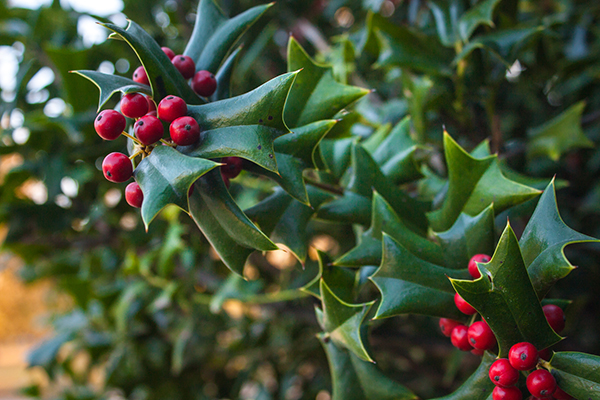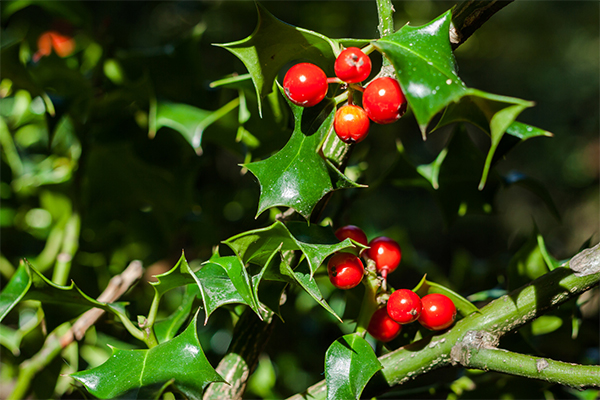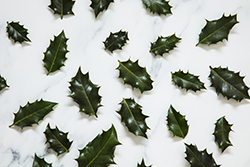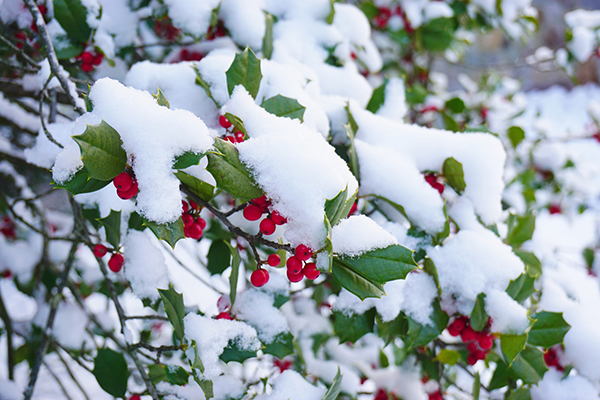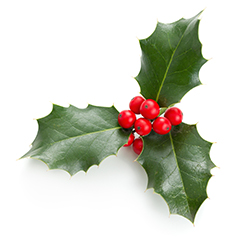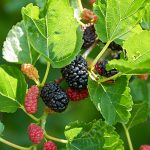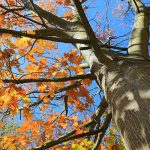We return this week with our ongoing series about the native trees of the Chicago area to get you into the holiday spirit with an in-depth look at holly trees. Holly trees (Ilex sp.) are evergreen or deciduous trees that are found in temperate and subtropical regions around the world, including North America, Central and South America, Asia, and parts of Europe and Africa. Holly trees are best known for their dark green leaves and bright red berry-like drupes, and they are typically planted as an ornamental tree. These trees are closely associated with the holiday season because it is common for holly branches and wreaths to be used as Christmas decorations. Holly trees and shrubs are hardy plants that keep their color and appearance into the winter.
When accounting for the various species of trees and shrubs, there are around 600 species of holly worldwide. There are many holly tree species found in the U.S., mostly in the eastern and southeastern regions. The two main species of holly trees found in the Chicago area are the American holly and the winterberry tree. For our purposes, we will focus mostly on the American holly and winterberry trees, and we will briefly cover several of the main species of holly trees found throughout other areas of the U.S.
Throughout our look at holly trees, we will discuss their general characteristics, common species of holly trees, pests and diseases that threaten holly trees, and good care tips. Holly trees are an excellent addition to any Chicagoland landscape, whether it’s a tree or shrub, because their green leaves and red fruits provide natural beauty year-round. If your holly trees need additional care to stay healthy, talk to our professionals at Hendricksen Tree Care for quality tree care services. Our ISA certified arborists can provide excellent tree care and maintenance for your holly trees to help protect them from insects and diseases and allow them to grow to their full potential.
Characteristics of Holly Trees
Holly trees in general are evergreen trees that can be deciduous or coniferous depending on the species. Most hollies have glossy green leaves that stay green through the winter, and they produce inconspicuous white flowers with male and female flowers appearing on separate plants. The bright red berry-like drapes, along with the spiny green leaves, are the defining characteristics of holly trees. The red drupes only appear on female holly plants and these plants must be pollinized by a male holly plant for the fruits to form.
The following are the main general characteristics of holly trees:
- Height: Holly trees are slow growing trees that vary widely in height, as they can be anywhere from 15 to about 80 feet tall. Hollies that remain a shrub can be as short as 3-4 feet tall. The American holly tends to grow between 40 and 50 feet in height and it has a dense, pyramid shaped canopy. Winterberry trees are on the smaller end of the holly tree spectrum and can be anywhere from 3 to 20 feet in height.
-
Leaves: The leaves of holly trees grow in an alternate pattern and are glossy green in color. The leaves for the most part are oval shaped and many species have serrated or spiny edges. Hollies do not lose their leaves in the winter. If the leaves on your holly tree start to yellow and fall off, this is most likely due to a disease.
- Flowers: All holly tree species produce inconspicuous flowers in the late spring. These small flowers tend to be greenish white in color and they appear in clusters. Holly trees are dioecious which means that male and female flowers only appear on male and female plants respectively.
- Fruit: The red berry-like drupes are a defining characteristic of holly trees and they are produced by most species. These fruits are part of what make hollies a favorite ornamental tree, especially when it comes to holiday decorations. There are many types of animals that eat holly berries, but they are quite toxic to humans.
- Bark: Most species of holly trees have smooth, gray colored bark that is quite thin. It is not unheard of for some hollies to develop lightly furrowed or warty bark, especially as they get older.
Species of Holly Trees
As mentioned above, there are around 600 total species of holly trees and shrubs found all over the world. There are also a wide range of holly tree species found in the United States. It is impossible to point out all of the holly tree species here, but we will highlight several hollies that you are likely to encounter. The following are the most common holly trees in the Chicago area and the U.S.:
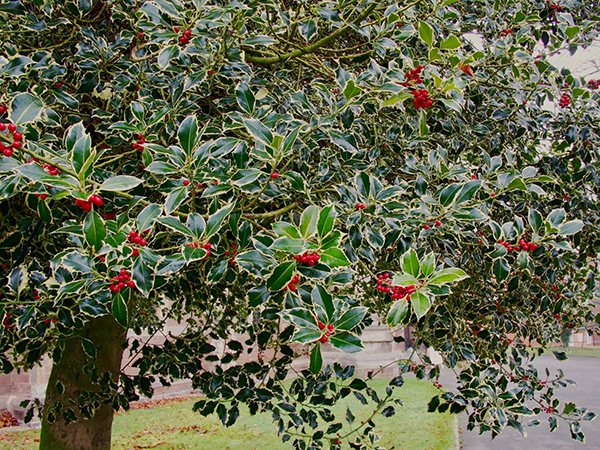
There are over 600 species of Holly Trees in the world, but 2 main species in the Chicagoland area: Winterberry and American Holly Trees
- American Holly: The American holly (Ilex opaca) is a medium sized holly tree native to the eastern half of the U.S., including the Chicago area. These trees have green leaves with spiny edges and produce bright red berries. They look very similar to European hollies and they are commonly used for Christmas decorations in the United States.
- Winterberry: Winterberry trees (Ilex verticillata) are smaller holly trees that are found in the eastern U.S. from Minnesota and southern Canada down to Mississippi and Alabama. These hollies generally appear as small trees or large shrubs and they are highly valued as an ornamental plant. They have round symmetrical canopies with smooth edged oval shaped leaves, and they produce clusters of red drupes that provide food for wildlife. The winterberry is the other main holly tree found in the Chicago area along with the American holly.
- Carolina Holly: The Carolina holly (Ilex ambigua), also known as the sandy holly, grows in dry conditions in the southeastern U.S. This species of holly is deciduous with pale green leaves that have small spines on the edges. These trees lose their leaves and fruit in the winter, so they do not have the same winter interest as other hollies.
- Catberry: The catberry (Ilex mucronata) is a shrub holly that grows in the eastern U.S. and can be found in Illinois. These hollies rarely grow beyond 10 feet tall and they have long stems called peduncles where the fruit appears. Its leaves generally have smooth edges and come to a point at the end.
- Dahoon Holly: The Dahoon holly (Ilex cassine) is a small holly tree that grows in swampy areas in the eastern U.S. as well as some Caribbean islands and Mexico. It grows between 20 and 40 feet tall and its leaves are oval shaped with smooth, rounded edges.
- European Holly: The European holly (Ilex aquifolium), also known as the English holly or Christmas holly, is the holly tree most often used as Christmas decorations. Its appearance is very similar to that of the American holly with spiny green leaves and bright red fruit. It is found in areas of Europe, Asia, and Africa.
- Hawaiian Holly: The Hawaiian holly (Ilex anomala) is a medium sized holly tree found on the Hawaiian Islands. They grow between 30 and 40 feet tall on average and have wide, smooth edged leaves. The fruit these trees produce is purple or black in color.
- Inkberry: The inkberry (Ilex glabra) is a small holly tree found in the eastern and southern U.S. These plants have smooth, oval shaped leaves and produce black fruit. Some cultivars of this plant do produce white fruit. Inkberries also produce suckers and they can become a problem if the suckers are not removed.
- Yaupon Holly: The Yaupon holly (Ilex vomitoria) is a small to medium holly tree found in the southeastern U.S. that is drought tolerant and grows well in salty conditions. Native Americans used the berries of this tree in a ceremonial drink that would induce vomiting, which is what gives this tree its scientific name.
Natural Threats to Holly Trees
Holly trees naturally are hardy plants that survive well into the winter. However, there are some diseases and pests that can have a harmful effect on hollies. The following are the most common diseases and pests that can harm your holly trees:
Pests
- Scale: Scale are tiny insects that feed on trees and leave behind honeydew secretions that can also damage the tree. These infestations start when a female lays eggs on the tree that hatch within a few weeks. The nymphs then find a good feeding sight on the tree and begin feeding. As they feed, they become immobile adults that look like small round bumps on the tree. In large numbers, scale insects can cause damage to the tree if they devour enough of it, and the secretions they leave behind can cause mold to grow on the leaves. You can control scale by pruning the affected areas or applying horticultural oil.
- Spider Mites: Spider mites are very small white or red mites that feed on the leaves and build white webbing. The biggest indicators of a spider mite infestation are the webbing and yellow or tan spots on the leaves. You can control spider mites naturally by introducing a natural predator such as ladybugs, or by spraying the tree thoroughly with a hose. Insecticidal oil is another effective way to eliminate spider mites.
- Leaf Miner: The holly leaf miner is a pest that feeds on holly leaves and causes unsightly yellow and brown spots to appear. Adult leaf miners look like small black flies and its larvae are brownish gold in color. Foliage affected by leaf miners needs to be removed and destroyed and the tree must be treated with insecticide.
Diseases
- Tar Spot: Tar spot is a fungal disease that attacks the leaves of holly trees. It usually develops in the spring in cool, moist conditions and causes small yellow spots on the leaves that will become brown or black in color. Eventually the leaves will fall from the tree. Foliage infected by tar spot needs to be removed and destroyed.
- Canker: Canker is another fungal disease that attacks the branches of holly trees. This disease causes sunken areas to appear on the branches which will eventually cause the branch to die. Infected branches must be pruned right away.
- Purple Blotch: Purple blotch is a condition caused by environmental factors such as drought or nutrient deficiencies. Purple colored spots will appear on the leaves of affected trees and cause damage to the leaves.
- Spine Spot: Spine spot occurs when the spine of a holly leaf punctures another leaf. A gray spot with a purple edge will appear at the puncture spot.
- Scorch: Scorch can be caused by temperature fluctuations, especially in the late winter. This will cause the leaves to turn brown. Planting your hollies in the shade can prevent scorch.
- Chlorosis: Chlorosis is a condition in hollies that is caused by an iron deficiency. This causes the leaves to become pale green or yellow in color. You can treat chlorosis with iron fortified fertilizer or by lowering the pH level of the soil.
Holly Tree Care Tips
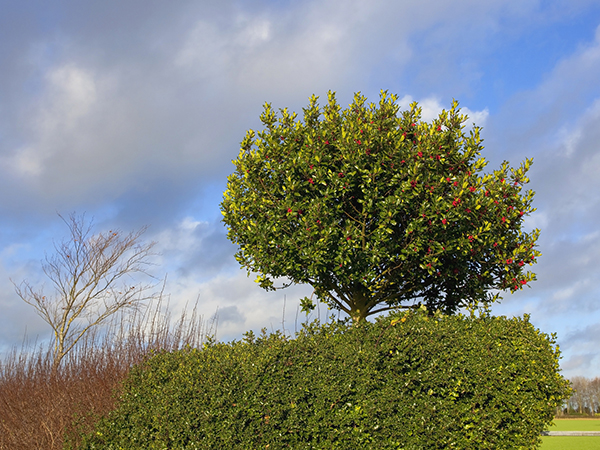
Holly Trees are relatively easy to care for when planted in the right location. They will provide a unique look year-round to your commercial or residential landscape!
Holly trees do not need much tree care due to their hardiness, but you can help your holly trees avoid pests and diseases and remain vibrant all year with adequate care. The following tips will help you care for your holly trees:
- Planting: Most holly trees do the best in acidic soil that is well-drained. Remember, if the pH of the soil is too alkaline, the tree could develop chlorosis. These trees should be planted in an area that gets full to partial sun and has enough space for them to grow to their full size. This is important because holly trees do not transplant well.
- Water: Hollies generally get enough water from natural rainfall. During a drought, water your holly trees once a week.
- Mulching: Holly trees have shallow roots so it helps to lay down several inches of mulch. The mulch will protect the roots from freezing.
- Fertilization: Fertilizing your holly trees in the spring and fall can help with its growth and development. Using iron fortified fertilizer will help prevent chlorosis.
- Pruning: Pruning hollies is a great way to keep their shape and remove damaged or diseased branches. Make sure you only prune branches back to a growth bud. If you remove a branch completely, it may never grow back. Hiring a professional for pruning will ensure that it is done right.
Professional Tree Care Services for your Holly Trees
Holly trees are beautiful ornamental trees with showy fruits and leaves that last year round. Even though these trees are closely associated with the holiday season, they will bring your yard or landscape much beauty the rest of the year as well. While these trees are quite hardy, you still need to watch out for common problems like insect infestations and diseases. Working with a tree care professional like Hendricksen Tree Care will help protect your trees from these common problems.
At Hendricksen Tree Care, we offer complete tree care services to care for your trees including pruning, fertilization, and the prevention, diagnosis, and treatment of insect infestations and diseases. Our arborists are ISA certified and will take the proper steps to keep your trees vibrant and healthy throughout the year. We provide complete tree care services for the northwest Chicago suburbs including Arlington Heights, Northbrook, Lake Zurich, Mount Prospect, Palatine, Winnetka, and the surrounding areas.
Look for the next blog in our series about the native trees of the Chicago area.
